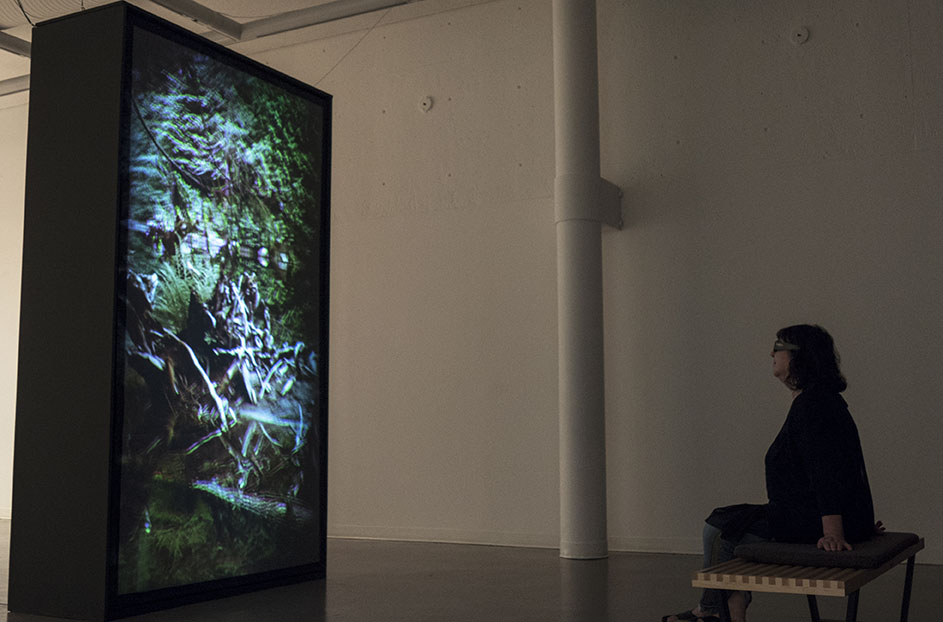Photo Credit: Jorge Zavagno
Artists Explore the Forests and What Lies Ahead
by Mike Devlin/ Times Colonist
May 17, 2018 06:00 AM
EXHIBITION
What: Supernatural: Art, Technology and the Forest
Where: Art Gallery of Greater Victoria, 1040 Moss St.
When: Saturday through Sept. 3
Admission: $13 (adults), $11 (seniors and students), $2.50 (ages 6 to 17); children five and under are free
Information: 250-384-4171 or aggv.ca
Note: Admission on May 19 is free from 10 a.m. until 5 p.m.
The junction where technology meets the environment has become an uneasy meeting point in the modern era. A bygone phrase about ecological conservation — “Take nothing but pictures, leave nothing but footprints, kill nothing but time” — would suggest humankind’s need to dig deeper into the biosphere runs contrary to the ecosystem ethos. On the other hand, how do we learn about the environment without studying it?
That’s what a new exhibit at the Art Gallery of Greater Victoria is attempting to answer. Supernatural: Art, Technology and the Forest, which opens Saturday and runs through Sept. 3, is a multi-media presentation that uses videos, photos, and computer-generated images to examine the forests of B.C.
The goal is to better understand the forest and how human interaction with it will adjust, according to exhibit curator Haema Sivanesan.
“People have always lived with and alongside the forest,” Sivanesan said. “If we look at Indigenous histories and go back further than our modern idea of what the forest is, we’ve always had a relationship to forests and forest landscapes. Maybe this [exhibit] is trying to think through some of those bigger questions.”
There is an underlying sense of inspiration about the exhibit, one that can be encapsulated by 19th- century philosopher Henry David Theroux: “It’s not what you look at that matters, it’s what you see.”
Sivanesan loves what Supernatural: Art, Technology and the Forest offers in that regard. “It’s looking at how artists are using new technologies, and a lot of that is camera-based technology, whether it’s as simple as digital photography or 3D video. All of it has to do with a camera, in some way, and how they are using that to look at the forest in a new way.”
Eight Canadian artists (Mike Andrew McLean, Kelly Richardson, Carol Sawyer, Trudi Lynn Smith, Sandra Semchuk, Dan Siney, Leila Sujir and Ian Wallace) and one collaborative team (Ayumi Goto and Sandra Semchuk) are participating. Their art ranges in tone and medium, from Richardson’s computer-generated imagery with sound that takes up a whole room of the gallery to Sujir’s blackbox-style Imax 3D captures of the Walbran forest.
“It’s very compelling because it’s working between the two genres,” Sivanesan said of Montreal-based Sujir’s work. “We’ve all looked at photos from very famous photographers like Ansel Adams, who’ve taken pictures of national parks and forests we are very familiar with. Because of this new technology, it’s allowing artists to do different things and understand the forest in new ways.”
The contributions of Victoria artist Trudi Lynn Smith are of particular note. Her “Breath Camera,” a hand-built prototype housed in suede, presents what the viewer sees in tandem with what they feel while immersed in a camera-form cloak. Smith serves as a guide, shepherding the participant through a journey using only lenses from an old optician’s kit — to play with reality through what she calls “noticing.”
“It is meant to show how simple it was to build a camera and how difficult it is to take a photograph,” Sivanesan said of Smith’s installation. “It has more to do with making us think about how we look at the world. Everybody has a cellphone these days and it’s so easy to just snap a picture. This is talking about the complexities of that.”

